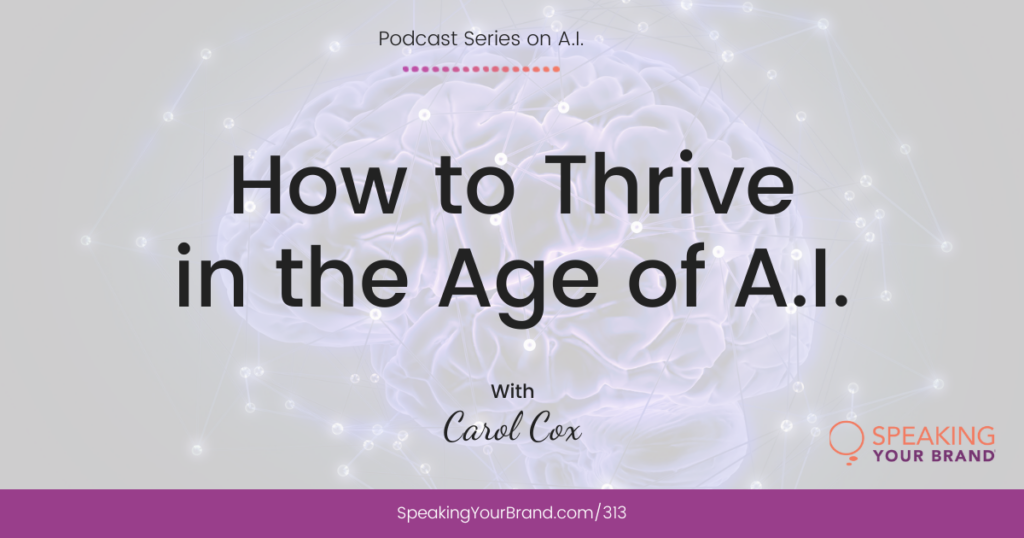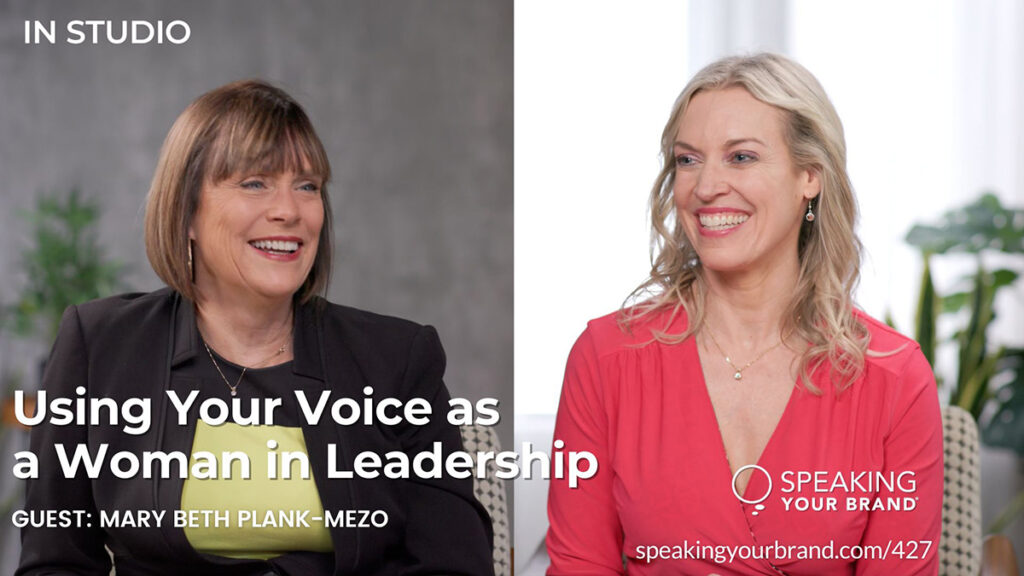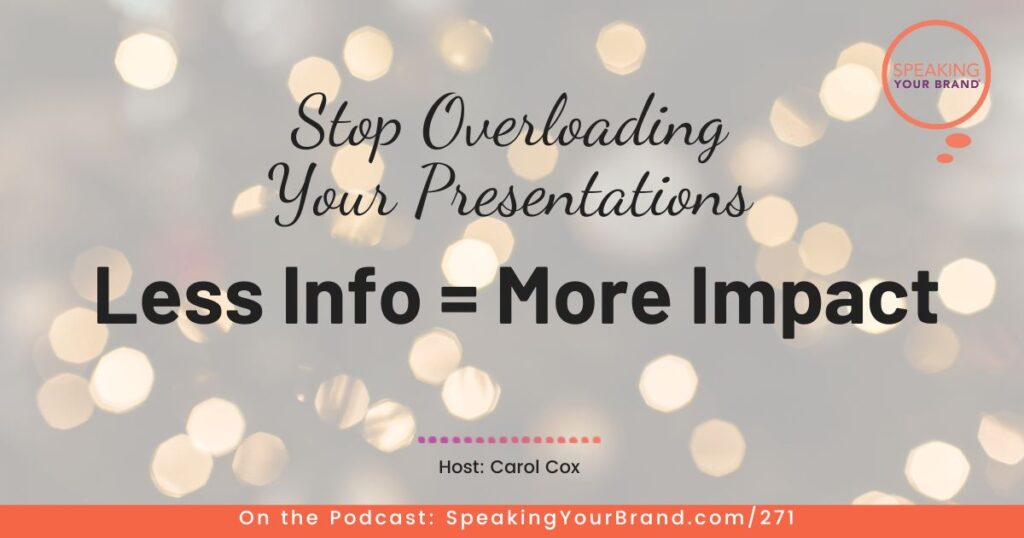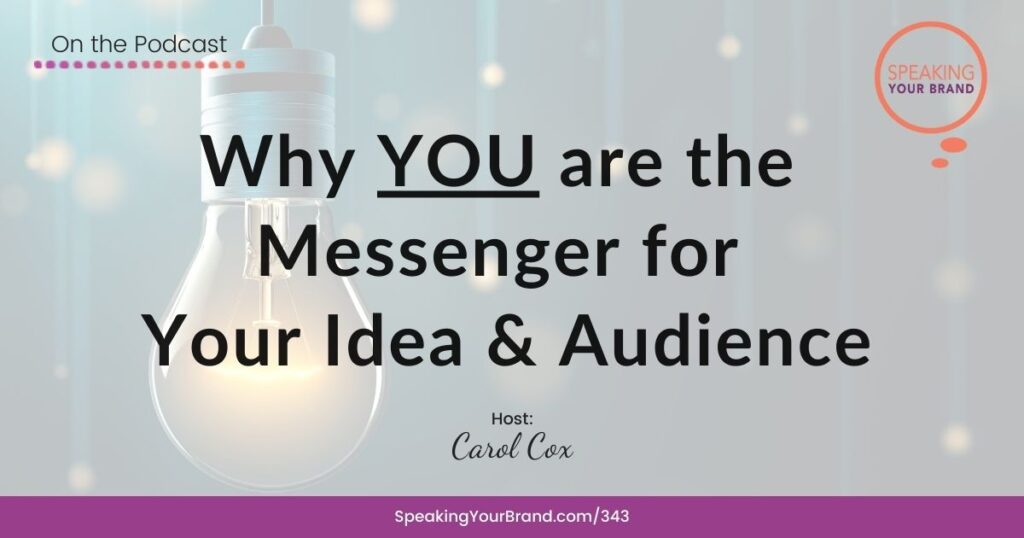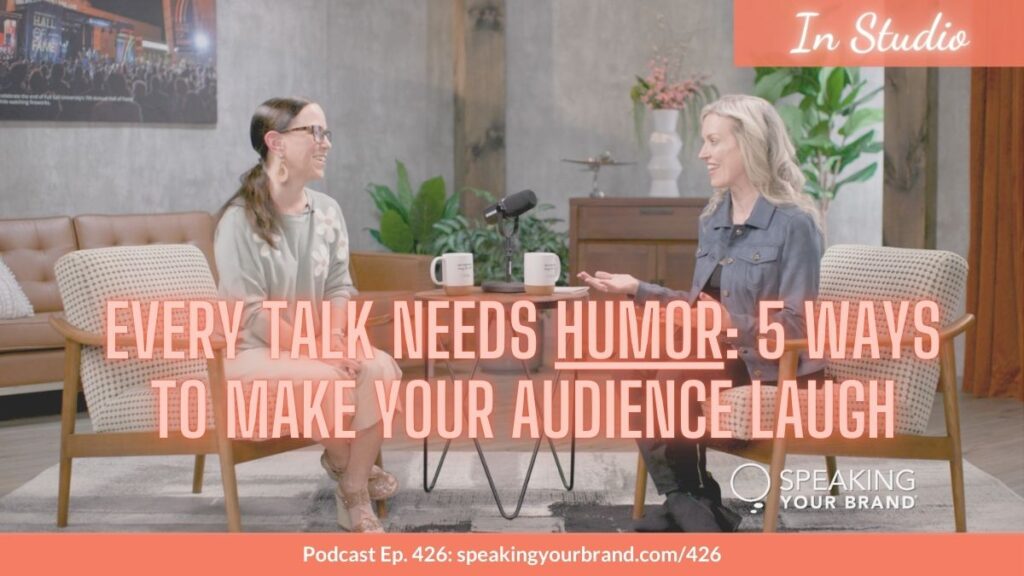313-SYB-Thrive-in-Age-of-AI.mp3: this mp3 audio file was automatically transcribed by Sonix with the best speech-to-text algorithms. This transcript may contain errors.
Carol Cox:
What does it mean to be human in the age of AI? I have some thoughts about this that you’ll hear on this episode of the Speaking Your Brand podcast.
Carol Cox:
More and more women are making an impact by starting businesses running for office and speaking up for what matters. With my background as a TV political analyst, entrepreneur and speaker, I interview and coach purpose driven women to shape their brands, grow their companies and become recognized as influencers in their field. This is speaking your brand, your place to learn how to persuasively communicate your message to your audience.
Carol Cox:
Hi there. Welcome to the Speaking Your Brand podcast. I’m your host, Carol Cox. I’ve gotten such great feedback from the Trends episode that I did at the beginning of January. That was episode 310. Definitely listen to that one. If you haven’t already identify three trends for us to look out for for 2023, the first one being the rise of artificial intelligence AI tools like ChatGPT. The second one was about the shift that we’re going to be experiencing in online marketing because of those AI tools, but also because of some other things that are going on, particularly with social media. And then the third trend was the resurgence for in-person activities and events and just doing business in person and doing more things in your local community. So I wanted to focus this episode on how we can thrive in this new age that we’re entering. As I talked about in that Trends episode, these AI tools like ChatGPT and DALL-E are getting better and better really quickly.
Carol Cox:
They are what are called generative AI tools, which means that they can generate text, images, sounds and other media in response to prompts that you give it, so you give it a text instruction or a text prompt and then it’s going to generate that essay for you or the outline for you or that image for you. And so as speakers, content creators, marketers and entrepreneurs doing the same things we’ve always been doing isn’t going to work for much longer. I can produce endless content at virtually no cost. Everything from text, audio, books, podcasts, video, images, photos. Microsoft researchers recently announced a new tool called VALL-E, so V as in voice. So kind of like DALL-E is for images. This one is V for voice, and it can closely simulate a person’s voice when given just a three second audio sample of that person’s voice. So just 3 seconds and then it can duplicate that person’s voice. Obviously that has major implications for deepfakes. I can’t even imagine what political campaigns are going to look like. Microsoft has not yet released this AI tool to the public, probably for good reason, as you can imagine. But these things are going to be released to the public at some point, and that’s why we’re going to have this huge shift in online marketing and social media marketing. I’ve seen people say people who work in AI say that in the next few years, so maybe in the next 3 to 5 years, which is going to come pretty quickly, the majority of content that we interact with, create or distribute will be synthetically or artificially generated.
Carol Cox:
And I’ve seen stats that up to 90% of the content that we see online is going to be artificially generated. This is why I feel like we can’t keep doing the same thing we’ve been doing with online marketing and social media marketing. We’re going to have this flood of content. We’re going to have to figure out how to differentiate ourselves, how to stand out. And I really believe that doubling down on what makes us human. I know that sounds really cliche and corny, but bear with me. I’m going to talk about specific things, but doubling down on what makes us human as opposed to the AI, and then really having these in-person activities and events and being more involved in your local community is going to have a big impact on your business. And of course, then as a public speaker, when you’re standing in front of an audience, especially an audience where you’re in person, but even if you’re doing it, say a Zoom presentation or a webinar where they know us, you really you, you have a captive audience in front of you. Now it’s up to you to deliver that transformational talk, that experience for your audience. If you’re new to speaking your brand and welcome, I’m so glad to have you here.
Carol Cox:
So yes, on this podcast we talk a lot about public speaking as well as thought leadership, but I am going to be talking much more about artificial intelligence and the shift that we’re going to be seeing in in marketing and in content creation, because I think it’s so important, no matter what your business is, no matter what your industry is as speaking your brand, we empower women entrepreneurs and professionals to confidently and effectively communicate their unique brand message and story to a wider audience. Our coaching and training services help our clients develop their thought leadership platforms and create compelling signature talks that inspire and influence others. We believe that by amplifying the voices of women and increasing their visibility, we work towards disrupting the status quo and driving positive change in the world. If you’d like to learn more about how we can work together, go to speaking your brand dotcom. And by the way, that paragraph that I just read you was a rewrite that Chad GPT did based on the original paragraph that I fed it. So it definitely kept some of the key words, but it changed some of them. So and I kind of like what it wrote. It’s a little bit different than what my original was. So that’s one of the ways we’re using ChatGPT is to do some rewrites and see what it comes with. But I’ll be talking more about that in next week’s episode. Now my background is in addition to having.
Carol Cox:
Degrees in history is in technology, in software development. I did software development and web development for about 12 years and long ago. This was like 2006, 2007. So we’re talking wow, over 15 years ago now, the software that we created to help political candidates and organizations, we actually used predictive tools to look at voting records. So we would take a subset of voters who we knew say we’re registered Democrats, and we looked at all the different characteristics that they had in common, and then we would try to predict other sets of voters say that they were independent voters or no party affiliated voters to look to see if they would match some of those Democratic voters. And so this was these were very rudimentary tools 15 years ago. But that’s how that’s how much I’ve been interested in this space ever since then. And that’s really what these AI tools are doing right now, is that they’re making predictions, tools like GPT literally just predict what the next word in the sentence is going to be. These image generators are also predicting what they think the image should look like based on the prompts. And we used to think that as humans, our intelligence, our cognitive abilities, even art and creativity were what made us human. And that’s really no longer the case, because these AI tools are great at a lot of the things that we thought were really just our domain, like writing really great stories or producing podcast episodes.
Carol Cox:
And by the way, I will let you know when I get to the point, if ever maybe I’ll probably do some experimental podcast where it’s not me, maybe it’s either ChatGPT wrote the episode or is using or there’s an AI tool that can replicate my voice. I will definitely let you know. Until then, everything that you’re hearing is me. This is real. So these AI tools are really good at writing these things and predicting what we’re going to say next. And these image creation tools are creating amazing art. Ai. We had an alumni call recently in January and I showed some examples of the art that these tools are are making. And the the women who were on the call were blown away because they really are there, aren’t I? I find that they’re artistic. The level of detail, the quality kind of even. I mean, I hesitate to use the word imagination, but it seems like there’s a lot of just imagination and creativity in it. So along with things like predicting what word is next and writing tools or creating these images, AI tools are going to get better also at problem solving and decision making. And so for us as entrepreneurs, as marketers, as content creators, as speakers, as thought leaders, it’s even more important than ever for us to escape what I’ve called the export trap. I’ve been talking about this particular phrase, the export trap, since 2021, so almost two years now. And the idea is that if we truly want to step into thought leadership and we want to provide a transformative experience for our audiences, we have to give them more than just the facts, just the the tactical strategies or just the the tips and techniques in our domain area for our topic.
Carol Cox:
Instead, we really need to help our audiences think differently to ask questions. And now that is even more so than it was six months ago or two years ago, because these artificial intelligence tools, they have all the information that’s on the Internet, pretty much they’ve scooped it all up. They’ve analyzed it all. So they truly are now the experts in those areas. Now, I’ll do a little asterisk here that these AI tools are not infallible. They sometimes come up with nonsensical answers or things that are clearly not factually accurate, but they will get better and better at that. But they are the domain experts on all of these different things. And what we need to learn how to do is how to use these tools, what to ask them to get what it is that we want. But now here you as the speaker, as the thought leader. But I want you to really start thinking about is how can you help your audiences understand the bigger picture of what’s going on for themselves within your topic, within your industry, and get them to think differently and to ask questions and to reflect and analyze what they need to do next.
Carol Cox:
And so I want to talk today about this shift from the attention economy to what I’m calling the embodied economy. So I believe what’s going to happen, especially over the next few years, is that we are going to have this explosion of online content created by AI. We’re also going to see more things going on in, quote unquote, the metaverse, whatever that’s going to end up looking like. So virtual reality, augmented reality, the metaverse. So we’re going to have all of these things going on online. But I feel like what’s going to be running in parallel to that is what I’m calling this embodied economy. So what is embodied mean? It means literally having a body so expressed, personified or exemplified in concrete form is what Dictionary.com said. So having or provided with a body. And that’s really what it means to be human. And so I would say that having experiences like literally having experiences, whether it’s going to a concert, going to a play, traveling, having experiences with other people, looking at nature, having those moments of awe, then sharing those experiences with others. Helps us to connect with each other, but also helps us to feel like we’re not alone for ourselves as the ones who are sharing the experiences, but then also for the people who are hearing it on the other side to validate what they may also have experienced. And I would call these embodied experiences things that happen to us precisely because re human. Those experiences and those feelings of love and joy and contentment and success, and or then also those experiences and feelings of disappointment, of failure, of loss.
Carol Cox:
All of those things are what makes us human. And so this is why for so long on this podcast and with our clients and our thought Leader Academy is I talk very much about finding the emotional heart of your message. I did a podcast episode back about a year ago, Episode 263, called Finding the Emotional Heart of Your Message. So I believe that’s one way that we can lean in to this idea of embodiment. And the embodied dichotomy is to tap into our emotions and to be willing to share that with our audiences, how we’re really feeling, why our topic is so resonate so much with us, why this topic is something that we care about, that we want to speak to audiences about. What’s the emotional heart of that? Where where did that interest come from? What experiences or stories of situations have you had that have led you to that? So that’s one area is really thinking about those embodied experiences and the emotions that come from it. The second thing as speakers that we can do is really seek to truly engage with our audiences. I know that we’ve all been in those ballrooms, the conference centers, the the breakout sessions where we’re listening to a speaker and it feels entirely one way the speaker is up there. Maybe they have notes in front of them, maybe they have slides that they’re looking at or that they’re reading from, and it’s just a one way monologue, just a one way lecture.
Carol Cox:
And so those things we can get by reading an article instead. The AI tools can just give us that information instead. But we really want we want to do as speakers and thought leaders is to engage our audiences. So engaging them by asking them questions, things like show of hands, questions, answer out loud questions, turn to the person sitting next to you and chat with them for a minute or two about whatever the question is. Also, engagement in the sense of giving your audience moments to pause. To reflect. To think for themselves. About what you’re sharing with them. Part of engagement is also recognizing the energy of your audience and how that energy will shift during the time that you’re speaking to them. And that also different audiences have different types of energy. You could give literally the same presentation word for word to one audience. And the group dynamic is so different than giving it to a different audience. And I have seen this happen myself. I know I’ve heard from clients where this has happened, to where they go and present to one audience and everyone is super engaged and answering questions and they’re really into it. And then they go give the same presentation, maybe even just a week later, and the audience is crickets. They’re not responsive, they’re not interested, they’re not engaged.
Carol Cox:
And even though it could be similar type of audience, for whatever reason, just group dynamics are different. So one of the things this is an advanced tip as speakers is to make sure is making sure that we understand where our audience is in any given moment and then giving them whatever it is that they need next. Do they need a few moments just to pause and to reflect? Conversely, do they need to raise their energy? Maybe they need to move around, maybe they need to stand up, maybe you need to have a dance break. This is especially true for longer speaking engagements like workshops where you’re going for several hours. But even if it’s just 30, 45 minutes that you’re presenting, still recognizing how these energies will shift from the beginning, middle and the end. And this is one of the things that we do at our client retreat speaking intensive that we have coming up at the end of February, coming up soon in Orlando, Florida. We have three days together that we spend and we give instruction and training to the women who will be attending. They get to practice on our stage and then the third day they get professional filming of their speaking segments that they can use in their speaking role. And one of the things that we do talk about is audience engagement and recognizing energy in addition to the other speaking segments related to emotion humor, you’re opening your closing and so on.
Carol Cox:
So that’s the second thing is engagement. And then the third thing is really envisioning helping your audience to imagine, to vision, to dream, to hope for a better future. So again, as speakers, as thought leaders, one of our primary roles is that we truly are leaders in front of our audiences, and we’re helping them to imagine to envision what they want next for themselves, for their businesses, for their community, for society. And this is we get back to this idea of escaping the export trap and be willing to ask questions to your audience even when you don’t have the answers. Because we may not have the answers. I don’t have the answers right now about what this new world of AI is going to look like, but I’m willing to explore that question. Even this episode that I’m recording right this moment. I’ve been working on this for the past couple of weeks and it doesn’t really feel finished yet to me, but I’m still willing to put it out there to you because I want you to start thinking about these things and I want you to start asking questions related to this. And so I’m not going to wait until I feel like it’s perfect or I have perfect answers because I’m never going to have perfect answers to this. But instead I wanted to put it out there for this idea of an embodiment and really doubling down on what it means to be human. So what I just talked about was emotion, engagement and envisioning.
Carol Cox:
And of course, you may notice that all three of those start with E So we have those three E’s emotion, engagement and envisioning to go with our E of embodiment. Finally, the other thing I will say about thriving in the age of AI as humans is to really think about the wisdom we’ve accumulated over our lifetimes. Wisdom from personal life experiences, wisdom from our professional experiences as well. Ai tools are really good, again, at domain expertise. They can they know what’s on the internet and they can put it together. What AI tools aren’t good, at least as of yet, is really being wise. They don’t understand what it is that they’re stringing together word by word, but we can understand that. And we this is why I tell our clients so often who are working on TED talks and keynotes that I want you to think about those hard won life lessons. That’s where wisdom comes from. I hope you enjoyed this episode. If you did, please share it with a friend or a colleague. You can just text it right from the podcast app that you’re listening to this on. And next week’s episode, I’m going to talk about how to use ChatGPT and image generators to enhance your content. So I’m going to share how we’re using that here, speaking your brand, how I’ve been using these tools and how you can use it to enhance what you’re already doing. Until next time. Thanks for listening.
Sonix has many features that you’d love including enterprise-grade admin tools, automated translation, automatic transcription software, powerful integrations and APIs, and easily transcribe your Zoom meetings. Try Sonix for free today.

